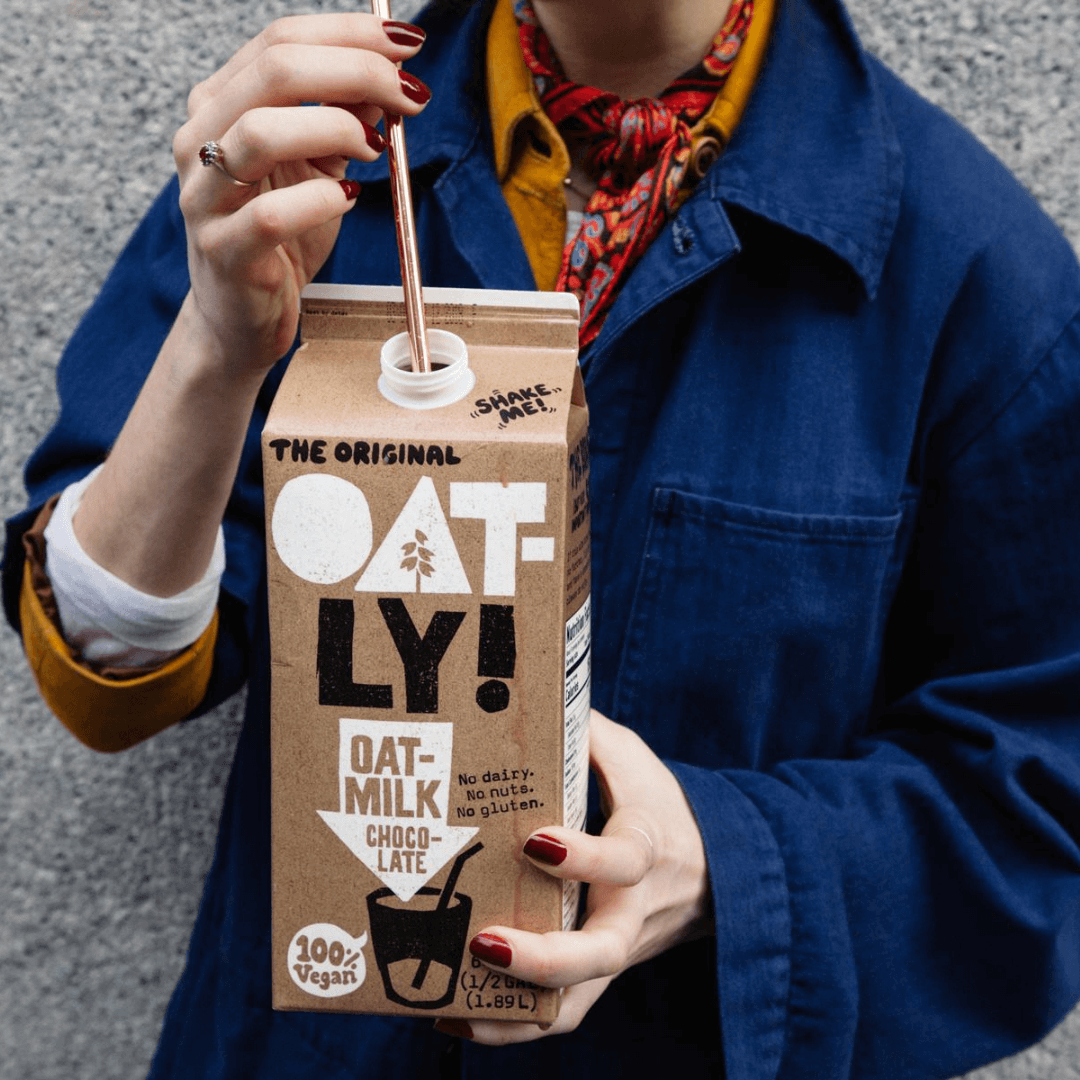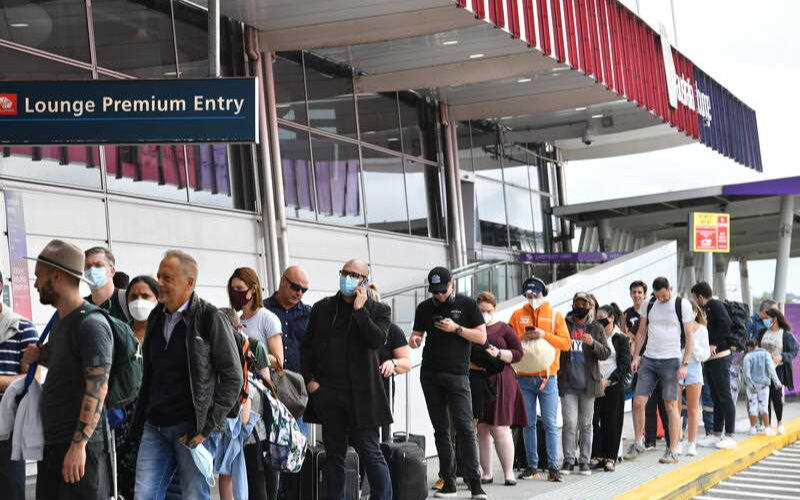
This post was originally published on Michael West.

This post was originally published on Michael West.

This post was originally published on Michael West.

Have you ever wanted to scream into a void about all the annoying things your meat-eating uncle says to you during Thanksgiving? Is a locker room motivational speech the best way you can think of getting hyped up before facing your family during the holidays? You’re in luck because vegan company Oatly is here to help you navigate traditional Thanksgiving like a pro.
This Thanksgiving, The Oatly Emotional Support Hotline for Plant-based Eaters will offer unique resources for vegans looking for support during the challenging holiday. What happens when you call in? Well, you’ve got options.

Oatly
First, you can listen to the main menu in different formats, including in English or Swedish, accompanied by smooth jazz or elevator music, or read by a fifth grader from Kansas who won a Thanksgiving essay contest.
Pressing one will get you to personal affirmations to help emotionally navigate a traditional meat- and dairy-heavy Thanksgiving dinner. Pressing two will get you to useful stats and talking points to defend your reasons for going vegan from a climate perspective.
Want to scream into a void about your frustrations about explaining your plant-based diet to people? Oatly gives you 30 seconds to do just that by pressing three.
Pressing four will get you to a locker room-style motivational speech inspired by—but not completely plagiarized from—the 1993 sports film Rudy. Other tools on the hotline include tips about weaving the benefits of plant-based eating into conversation and deflection tactics (such as asking if there is smoke coming from the oven) when the conversation gets too daunting.
“We know that every Thanksgiving, millions of plant-based eaters endure a heavily meat- and dairy-based holiday meal with family and friends who don’t necessarily understand or accept their dietary choices,” an Oatly spokesperson tells VegNews.
“Oatly of course feels for our likeminded plant-based friends and wants to arm them with all the help they could need to not only get through these holiday meals but even positively influence dinner conversations, so that’s why we’ve decided to introduce The Oatly Emotional Support Hotline for Plant-based Eaters,” the spokesperson says.

Oatly
The hotline can be accessed starting today and until November 24 by calling 1-866-OAT-LINE.
In addition to all of the aforementioned resources, Oatly’s hotline will be operated by plant-based experts on Thanksgiving Day (November 24) from 3pm to 10pm EST. These operators will be on hand to answer questions and help plant-based eaters get through last-minute preparations before sitting down for Thanksgiving dinner.
“It’s a way for Oatly to take a virtual seat at your holiday dinners, but do it in our very own way, always bringing a dose of lightheartedness—like dialing a number to let out a cathartic scream,” the spokesperson says. “And, of course, to serve as a reminder that it’s a great time to school your family and friends about all the delicious, climate-friendly, and dietary benefits of plant-based food.”

Oatly
For Thanksgiving, Oatly also partnered with James Beard-nominated chef Amanda Cohen, owner of New York City vegetarian mainstay Dirt Candy. Cohen recreated classic Thanksgiving dishes using Oatly’s products instead of dairy, including Pumpkin Pie Oat Bars, Creamy Roasted Mushroom Gravy, and Roasted Carrots with Oatgurt Dressing.
Oatly is known for its creative and humorous approach to ad campaigns. During the Super Bowl in 2021, Oatly CEO Toni Petersson appeared in a 30-second spot singing “it’s like milk, but made for humans” in a field of oats. The commercial gained traction, in large part for being so strange—which Oatly ran with by releasing a T-shirt emblazoned with “I totally hated that Oatly commercial” and image of its CEO.
Earlier this year, the vegan company worked with master puppet maker Andy Gent—who was behind the puppets in Wes Anderson’s Isle of Dogs—to create an ad campaign that furthered its mission to make oat milk the new normal. The campaign series revolved around five short episodes of fictitious “The New Norm & Al Show” which featured puppets “Norm” and “Al,” who cleverly discussed shifting from old habits (drinking dairy milk) to new ones like consuming dairy-free milk.
 Oatly
Oatly
While Oatly has its wits about it, the company recently reported that its third-quarter earnings missed the mark and is currently planning to reorganize the company, including by reducing its workforce, to cut costs by 25 percent.
“Third quarter financial results were below our expectations, largely driven by COVID-19 restrictions in Asia, production challenges in the Americas and continued foreign exchange headwinds,” Petersson said in a statement. “However, we continue to see strong velocities, year-over-year sales volume growth, and minimal price elasticity globally, which we believe demonstrates the power and resilience of the brand.”
This post was originally published on VegNews.com.
You’ve talked about how when you first got interested in ceramics, you completed a one year Post-Bac program at Louisiana State University. But you were also seeking out mentors and creating your own independent research. Could you talk a little bit about how you began that journey?
I don’t really frame it as research. I frame it as being curious and wanting to learn more about what it is that I do. I mean, this is my profession. So, I don’t know, it seemed like second nature to look deeper. I don’t see it as anything more sophisticated or complicated than wanting to look a little bit deeper into this thing that I’m in love with, and that is the way that I make a living.
When I found that I was attracted to working with red clay, I started Google searching the word “terra cotta” because I wanted to know more about the material and the associations of it. And then that led me to a lot of ancient pottery from the Bronze Age and West African pottery. My family’s from Nigeria, and a lot of the traditional ceramics are made with red clay. It was a Pandora’s box. One thing led to the next.
I know you’ve mentioned bridging history and a modern design sensibility in your work.
Yeah, definitely. I’m taking a lot of cues from historical ceramics, but then modifying what I’m finding to suit our day-to-day needs. I’m using these traditional forms, but changing them in such a way that suits our modern lifestyle.
I’d love to talk about the connections between the work that you did before you went into pottery full time. Do you see connections between the work that you did within the music world, your writing, and your activism—and the pottery that you’re making today?
Yes and no. I’m the same person, so I still care about the social impact that arts can have and always connecting my craft to social issues. So that’s something that’s never stopped for me. I still do that.
When you’re in a punk band, you set up your own shows. I set up a ton of shows for my band and other people’s bands. And that takes cold calling a space that may or may not be a traditional music venue and thinking outside the box and putting together that “who, what, where and why” to create an event. When I found ceramics, I had the same mentality of creating my own events. I used to put together pop-up events at plant nurseries and little boutiques in New Orleans—and places where ceramics may or may not have been sold, but I could relate what I was making to what they were selling, and we made a good collaboration. So just that mindset of not waiting for opportunities to come to me, but creating my own opportunities, definitely came from punk.
The biggest difference is the appeal. So there’s a universality with ceramics that punk doesn’t have. Punk is about being—I don’t want to use the word “exclusive”—but it’s so subcultural. It’s not meant to appeal to the masses. In fact, it’s in reaction to the mainstream. And there’s something about ceramics that is very universal.
As a person who takes a lot of these DIY approaches—finding spaces, finding collaborations—has it gotten easier over the years, or do you always change your approach to those collaborative practices?
It’s become a second nature way to operate in the world. But also, pottery has been way more of a solitary practice than being in punk. Punk is all about the scene, and bands are a group of people, not just one person. Right now, as I’m talking to you, I’m alone in my studio. And when I was creating those events, it was just for me. It wasn’t for a bunch of different bands, it wasn’t for me and my band mates—it was just for me. And then for people to come to shop, or to look at my work.
So I would say that punk was probably more collaborative, and that was a good and bad thing. Collaborating is a wonderful opportunity to combine energies with people and there’s wonderful chemistry that can happen. You can create art that is greater than the sum of the parts.
But the downside is that a lot of those collaborations were temporary. It was hard to get people, including myself, to commit on a long enough timeline. As I got older, I was craving consistency. And that’s why I think I turned to ceramics as an expressive medium because I could work on it by myself.
And so, here I am almost 10 years in, and I’ve been able to work consistently for a decade. In the beginning, when I started my business, I was sometimes working seven days a week and making pots seven days a week. And that was never a reality with punk bands where you have to schedule practice with two, three, four other people and maybe you can practice once a week. As someone who had an inkling that, “Hey, maybe I could be better at something if I gave it my all,” I burned out on collaborating and wanted to go solo. Because I knew that I could be more consistent by myself than with a group.
Do you have any advice for artists who are starting out, who really want to open up a little bit more in terms of collaborating but that are nervous or maybe feeling vulnerable about sharing their work?
I mean, there’s really nothing to say beyond: Just do it. I mean, most of our fears are an illusion anyway. What’s the worst thing that could happen? If you reach out to someone and they, say, don’t respond, you could just move on to the next person—and just assume that wasn’t the right person for you to collaborate with or connect to. But chances are, people are going to be pretty open. I mean, there’s just no other advice than just get out of your own way and stop overthinking and just do it. There’s so much to gain.
Every time I’ve spoken to another ceramicist, every time I’ve gone out of my way to meet someone and have a conversation, I’ve learned something.
For instance, I just moved to Florida two years ago. There’s a great network of ceramicists here. I started following an Orlando ceramicist named Richard Munster. He lives in Orlando, which is two hours away. When me and my husband were in Orlando, we decided to stop by his house and say hi. He had proven to be really friendly on the internet and was really open to meeting. He has a wood fire kiln in his backyard and showed us all this stuff. And I was talking to him about the wild clay that I forage every now and then, and how I wanted to work with it more. He’s a high school teacher and has a lot more formal education than I do. So he just mentioned a certain ingredient that I could add to my clay to make it more workable.
I went home and I figured it would be a little bit more complicated than that, and maybe I would need more than just that one ingredient. But that turned out to be the whole move. I could just add that ingredient to my wild clay and it made it so much more workable.
I wasn’t meeting him to pick his brain about anything. It’s just like, these natural conversations happen. I learned something that happened to be beneficial to my studio practice. And I have a hundred stories like that. There’s everything to gain from connecting with other people. And hopefully, you’re doing the same thing, as an artist. You’re willing to share your experiences and your knowledge because it will come back to you.
I’d love to talk about some of the recent videos and photos that you shared of your pottery, shot by Shoog McDaniel. What a great idea for a collaboration — to have someone else’s lens and present these ceramic pieces underwater, creating a sense of movement. Could you tell me a little bit about that collaboration?
Shoog and I are part of the same general scene of friends. We hadn’t hung out very much, but we’d met each other before. We have a lot of the same friends. They usually shoot bodies. They shoot a lot of fat bodies in water and queer and trans bodies, and they use water as this liberatory space where you can feel free of the weight of your body and you can experience lightness. I wasn’t quite sure if they were going to be interested in shooting pottery, to be honest. They don’t really do that. So I went with some pots, but I was like, “Maybe we’ll do this, maybe we won’t.”
I just went to hang out. It wasn’t like a business networking thing. It was like, we come from the same friend group, we come from the same ideological background of punk and DIY and the queer scene. I just went, being open to taking pictures or not. So what I was saying earlier about the chemistry of collaboration? That’s what you’re seeing.
Yeah, definitely. And I’m thinking, too, about Kaabo Clay Collective. When did you know, “Okay, I’m at a point in my own creative career and journey, where I have the mental space and the capacity to also work on this collective.” Was there a specific moment?
It came out of the response of the ceramics community to George Floyd’s death. It just felt like a thing of necessity. Also, I invented Kaabo for myself, and I think that’s how you have to go about things. You can try to frame it like community work or activism. But I’m a Black ceramicist in a town where there are no other Black ceramicists that I know of—and so, I needed that connection. And really, it started as just a chat group. So it didn’t take a lot of effort or money. It was free. And it was literally just saying, “Hey, I’m a Black ceramicist, I want to be connected with more Black ceramicists and I want to bring everybody together.”
So there wasn’t the idea of, “I’m going to create an organization from the ground up.” It was more just about taking the first step, doing what I felt like I needed to do for myself and if I need it, other people obviously need it. It didn’t feel like work, it just felt like something that was going to benefit us all.
Looking at it now, do you think, “Oh, this has grown in a way that I didn’t expect it to?” or do you feel like it’s progressing how it’s meant to?
I think that as soon as you put an idea out there, it’s bound to get more complicated. I mean, it just seems like that’s how things progress. I think it’s because I’m older. I mean, I’m 44, so this is not the first thing I’ve ever started. So I knew that what you do is you plant the seed—and then you just watch it grow. Honestly, I think it could grow faster if I wanted it to. I just don’t know if I want it to yet and no one else has stepped up to really push it. So it’s going at a pretty relaxed pace, which is fine with me, because we’re all busy.
I felt pretty confident that it would develop on its own. And I also figured that if it didn’t develop, then that just meant that it wasn’t useful and that people didn’t need it. And then what would be the point of it? I don’t really run it. I mean, I do to some degree, but it requires participation. It’s a collective. I’m not the head of it, really. If people aren’t participating, I’m going to take that as a sign—mostly it’s a sign that people are just busy. But if it dissolved, it would be because it’s an obsolete idea…But I really do see that a lot of people think it’s important and do pitch in to volunteer and make things happen. And that’s been really amazing to see.
And, how do you unwind, slow down, considering how busy you are from day to day?
Oh, I relax a whole lot. I’m actually not that busy. I mean, I work really hard, but I have a really great balance. And I mean, I run my own business. So if I’m running myself ragged, or if I can’t find time to relax, it’s my own fault. And I think that running a business can be a site of liberation.
It’s ironic because it’s business, which is capitalism. But I think as a business owner, you can redefine and control the circumstances of your work life. So that’s what I do. I’m really adamant about taking weekends off. In the beginning, it was harder to do that—I had to hustle a lot harder. I think it’s just overcoming that inertia. You’re just trying to get started. You’re trying to get the ball rolling. And I think that every business owner feels that way in the beginning. It’s just hectic. But I think after a while I was like, “Well, I can organize my life, things are rolling. There’s interest in my work. I need to adjust my pricing.”
Because what I see a lot of people doing is undercharging, and then you’re just always treading water. So you’re not charging enough for your work and it’s making you just too busy. And you’re constantly busy and constantly struggling…Yes, we’re all oppressed by the system, but there’s also decisions we can make. I just feel like as a business owner, I prioritize resting and I prioritize leisure and I take time off and I take breaks. And I don’t know—that’s part of my business ethic, I guess.
Some non-pottery links:
Shotgun Seamstress (anthology of zines by Osa Atoe)
Firebrand (music made by Osa Atoe)
Tropical Depression (music mixed by Osa Atoe)
“The Forgotten Women of Punk” (article about Osa Atoe)
This post was originally published on The Creative Independent.
Human rights council makes more than 300 recommendations, with many coming from less well-off countries
The UK must tackle rising poverty, the UN human rights council has said in a report that includes demands from less well-off countries for the British government to act.
Amid worsening financial prospects for millions, the member states of the UN body also demanded action on housing to prevent homelessness, better food security for young children, and equal rights for people with disabilities.
Continue reading…This post was originally published on Human rights | The Guardian.

This post was originally published on Michael West.

This post was originally published on Michael West.
Regional businesswoman and Order of Australia recipient Julia Spicer has been named Queensland’s new Chief Entrepreneur, replacing incumbent chief Gerard Wayne in the voluntary role. Ms Spicer, who is the fifth Chief Entrepreneur to be appointed since the government role was launched 2016, will take over from Mr Wayne when he finishes his 18-month stint…
The post Fifth Queensland Chief Entrepreneur appointed appeared first on InnovationAus.com.
This post was originally published on InnovationAus.com.

This post was originally published on Michael West.
This post was originally published on The Asian Age | Home.

This post was originally published on Michael West.
This post was originally published on The Asian Age | Home.
This post was originally published on The Asian Age | Home.
This post was originally published on The Asian Age | Home.
Advertisers trim budgets amid jitters over World Cup host’s human rights record and appearing ‘tone-deaf’ to austerity
There will be no Christmas TV advertising boom this year as jitters over associating with the World Cup host Qatar’s human rights record and the cost of living crisis put paid to the annual battle of the big-budget extravaganzas that traditionally bombard the public over the festive season.
UK companies will still spend a record £9.5bn in the run-up to Christmas, known as the “golden quarter”, when many retailers make the lion’s share of their annual profits and sales, but the amount targeted at traditional TV, newspaper and radio outlets will decline this year.
Continue reading…This post was originally published on Human rights | The Guardian.
World Uyghur Forum brings high court challenge against government agencies over Xinjiang cotton imports
UK government agencies have broken the law by not investigating the importation of cotton products manufactured by forced Uyghur labourers in China, the high court has heard.
The World Uyghur Congress (WUC) is challenging the home secretary, HM Revenue and Customs and the National Crime Agency (NCA), claiming a failure or refusal to investigate imports from Xinjiang, allegedly home to 380 internment camps, was unlawful.
Continue reading…This post was originally published on Human rights | The Guardian.

This post was originally published on Michael West.
This post was originally published on The Asian Age | Home.
This post was originally published on The Asian Age | Home.
Transform Trade charity says British-based companies are among main bringers of cases based on bilateral investment treaties
UK companies operating overseas are afforded far greater legal protections than the citizens of the countries they invest in, leading to corporations getting away with human rights and climate change abuses, a report has found.
The Transform Trade charity says the majority of UK bilateral investment treaties (BITs) contain no mention of climate change, the environment or human rights, meaning companies are not held accountable for violations.
Continue reading…This post was originally published on Human rights | The Guardian.
Exclusive: Meetings while in Saudi Arabia undisclosed due to ‘administrative oversight’, says business department
The chancellor, Kwasi Kwarteng, held undisclosed meetings with senior executives of Saudi Arabian firms when he was the business secretary, documents acquired by the Guardian show.
The meetings occurred in January, when Kwarteng visited the kingdom for a two-day trip under his previous ministerial role.

This post was originally published on Michael West.

This post was originally published on Michael West.

This post was originally published on Michael West.

This post was originally published on Michael West.
This post was originally published on The Asian Age | Home.

This post was originally published on Michael West.
Some of the readers of The Creative Independent might not be familiar with the techniques you use to create garments and objects. I was hoping you could start by telling me a bit about the things you make and how you make them.
It is kind of a complicated process with many steps. But basically, I mix a viscous water solution that I’m able to float paint on top of. Then I mix all of my paints to lighten them a little bit and help with their spreadability. Then I take that paint and I apply it to the surface of this buoyant liquid. Then I manipulate the paint to create patterns and imagery. Then I can take paper or wood or fabric, and lay it on top of the surface of the water and it transfers onto whatever material I’m printing. I take that material and turn it into all sorts of products and designs and artworks, from wearable clothing to home goods to prints on paper. My whole practice, pretty much, is rooted in that certain technique.
How did you arrive at that method?
I originally studied sculpture, but I’ve always made my own clothing and I’ve always manipulated clothes and done tie-dyeing or applique or…
Are you self-taught with sewing?
Totally self-taught, but I’ve always been really into clothing as a form of self-expression, and cutting things up from the thrift store and putting things back together. I was on this deep exploration of textile techniques and I tried marbling, I just fell in love with it. Because it’s so fluid and you don’t have that much control. So, it feels like this really nice push and pull of you manipulating it, and it sort of pushing back. It’s very freeing in that way.
I think I’d been looking for a technique that was freeing for me, because I was always living in these tiny, tricky little spaces and making work that felt really constricted and small, like tiny drawings. To be able to feel really open and expressive with the material that I couldn’t control too much was this ‘aha!’ moment for me.
What parts of your upbringing or your early adulthood do you think were key in preparing you to do the things you’re doing now?
This is a funny question, because I had a pretty intense upbringing and have an extremely high level of endurance because of it. So, I think that has helped me be very committed and really work hard. Also, not having a lot of support or money or anything. It’s like, “I am doing this and no one else is going to do this for me, so I have to just make this work on my own.”
But I also grew up with creative parents and we lived completely off the grid in rural Maine and we would just make everything. My parents’ approach to life was like, “We can make whatever we need.” They didn’t want to rely on anyone or anything. So, there was no electricity, no running water, build your own shelter, grow your own food, make your own clothes, that kind of mentality. I think that also has its pros and cons. But being raised with the idea that you can make something from nothing, and you can make something beautiful out of something hard or ugly or raw, is something that just continues to inspire me. It keeps me going to this day and I’m very grateful for that part of my childhood, for sure.
In terms of running your business and making the work that you make, what are some of the things you feel like you’ve had to unlearn from whatever you were taught in school or from family?
I think, connecting to what I just said, [the idea that] you can do anything. Unlearning that and actually asking for help with things that don’t come naturally to you has been something I’ve really struggled with. I’m getting so much better at reaching out and saying, “Actually, this would be more efficient if I reach out to someone who’s really good at this and ask for help and bring them in.” That has been a pivotal change in my practice.
Would you mind giving a specific example of a time you’ve done that?
I had my friend Jackie come in and help organize my studio, because I am extremely messy and disorganized. She loves organizing spaces and is so thoughtful and enjoys that. That was absolutely a game-changer. I had my friend Ariel help me—she just got a master’s in graphic design and helped me with website rebranding stuff. I am very analog, I’ll be there getting so frustrated and irritated. Then I’m like, “This doesn’t need to be what I’m putting energy into.” She needed the work and is really good at it. Then I just had all that space in my mind free up for other work. Even having my friend Perry who works with me part-time, having her come in and help me do shipping and stuff. I don’t need to be doing everything.
Reminding yourself that things can get done if you don’t touch every single thing.
Yes. And it’s okay. And it doesn’t mean that I’m incapable or whatever. The myth of the one woman show, that’s based in ego and it’s unrealistic. I think growing up being so endurant and doing so much on my own made me feel like that was part of my identity. Then, as an artist and a business owner, wanting to uphold that in some way, because that’s how I felt proud, and needing to really shift that narrative, because it was actually stopping me from growing.
What does success look like to you now?
This is a question I ask myself a lot, actually, because I’ve grown up with this narrative that I’m going to be the one to make it. One of the first people to go to school in my family or have a career that’s actually with my creative work. This idea of “making it” is just so abstract. Have I made it because I have my own studio? And I’m selling work and I’m making a living just on my work, is that making it? Or can you ever make it, really? I don’t know. It’s just like, what is success really? For me, I think it’s being happy and fulfilled, and it’s not about money or space or acknowledgement. So, I think my goal when I will feel successful is when I’ve tamed my mind to a point where I’m not being bogged down with other little mental distractions or where I feel secure in myself.
Something that I think we maybe have in common to some degree is from existing in kind of a chaotic environment in early life, we’re maybe too comfortable with chaos sometimes. But I think it’s really interesting to talk about chaos and control in how it relates to creative work. I wonder if you could share a little bit of your thoughts on the utility of chaos or the pitfalls of it.
Yeah. My process is extremely messy and I get paint on everything and water all over the floor. I love being able to create in a space of chaos, because I think it has energy and electricity and there’s no part of your brain that’s like, ‘Oh, careful!’ You’re just going for it and you’re able to get in the flow and let go. That’s when I make my best work, when I access the flow, which is my favorite state of being.
It’s like a form of surrender.
Completely. I mean, it’s kind of like a disassociation also. It’s like therapy. You’re floating and it’s just pouring through you and you’re not overthinking it. I think it really helps me to be in a chaotic, messy environment, because I’m not worried about anything. It’s okay to get super messy.
Do you have any rules that you’ve made for yourself as a creative person or as a business owner?
Yes. In the last year and a half, I have been really trying to be disciplined and have a good work-life balance, because I’m a total night owl and I would be coming to the studio and I would forget to eat, I would forget to drink water, I would be here till 3:00 AM. I wasn’t making time for anything else in my life. So consumed by my work, to the point of severe burnout, which is super real. I went through that and it was really hard to bounce back from and I never want to go there again.
Now I try to do nine to five, and I try not to work weekends and I try to always have snacks here. Getting my dog, Wanda, has been really helpful, because she reminds me to take breaks and go for walks. My boyfriend is like, ‘I’m picking you up at 5:00 and you’re coming home with me. You can go out, do whatever, see your friends, whatever, but you’re done at 5:00.’
When you are working how do you approach structuring your time?
I try to get here early and have some quiet time to look at books or write ideas down, and get myself centered and organized, so I’m coming into the day with calm energy instead of feeling frantic. I often feel like I never have enough time. Trying to create a calm start to the day, where I’m not entering the work in frantic energy has been helpful.
But I still work in a very abstract way and I still jump from one thing to the next. I am trying to have more of a structured day, where I have a task and I try to complete it and not get too distracted. I hide my phone when I come to the studio. I put it somewhere that I can’t reach, take my ladder and put it up there [points to a high shelf] and then move the ladder. Because I do not want to waste my time. If I’m only here from nine to five, I need to make the most of this day. I can’t spend an hour on Instagram.
So, part of work-life balance is being very protective of your work time.
That is so true. I am so protective. I am like a mother lion when it comes to my studio practice, extremely protective. That can be tricky with friendships or wanting to go visit super old friends. But I really do think that I am where I’m at now because I’ve been so committed and I’ve been prioritizing my work above anything else really in my life. I think it pays off when you really commit.
Can you talk about some of your priorities as a business owner, or some of the challenges you’ve had in how to structure this as a viable business?
As someone that studied fine art and conceptual sculpture, and then wanted to make a living off my creative work for a long time, I felt guilt and shame around making functional objects, because it wasn’t living in the fine art world. It took me a long time to let go of these rules of what deserves this sort of a claim and what doesn’t.
I think the more potential I saw in creating a living for myself with my work, and the more joy that I saw people having by being able to wear my work, those divisions started fading away more. But that has definitely been something I used to struggle with and a boundary that I still want to work on smudging out. I want these things to be able to coexist and I’m really excited that I’m making more work that lives on a wall. That feels exciting to me. I would love to have a show of my prints, but I’m also excited by having wearables coexist in that space.
This is something that I think a lot of small businesses toeing the line of art and design are confronted by, because there’s such a division still between those spaces. But it’s exciting to be existing on the edge of both. I feel like I’m inspired by the potential that can come out of merging them.
Can we talk a little bit about the way you use color and what sort of feelings you hope people have when they wear or experience the things you make?
It’s funny because I feel like I’ve been saying for a number of years now, “I’m going to do a tan and ochre collection.” I really want to try that and I just can’t. I am just obsessed and in love with color, I love all color. It makes me feel excited and happy. I love combining tons of colors. It feels energetic and alive. I think if there’s one thing I’m trying to bring is fun and confidence, because they’re really bold and bright, the things that I make.
There’s also a childlike sort of thing going on, because they’re like how a child would just throw every color on the page. I love that feeling of being really free with it. I think that there’s just energy that happens with bright colors and colors mixing. There’s that kind of optical illusion that happens with certain colors and you put them next to each other. And also nature is full of neon color. I want to draw from the extreme and extroverted and eccentric parts of nature that are just like, “What is this crazy frog that is covered in neon dots or this wild flower that’s blooming out of a cactus.” That’s the feeling that I’m trying to evoke.
Yeah, my suspicion is that you make a lot of people really happy when they wear your stuff, because how can you be a grouch and wear a smiley face with heart cheeks in ten shades of neon?
Even when I’m approaching a trickier emotion, with the mixed emotion faces that I do, I’m injecting humor into it, because it’s done with super bright colors and it gets goofy. I think that feels really therapeutic to me. It’s like you can be sad, but there’s still this feeling of joy lurking within it. Or saying it’s okay to have these feelings, but also here’s something that’s going to make you feel happy.
What advice would you give to other artists on how to have more joy in their lives?
I think I would say, make a list of things that make you happy and prioritize those. Try to make time to prioritize them. If you feel nourished by going into nature, try to make time to do that once a week or once a month. And be kind to yourself. And find time to play. And nourish your inner creative child, because I think that’s where the source is for all of us. If that child is being neglected, then it’s harder to access joy. So, play.
Maisie Broome Recommends:
Adopting a pet (I found Wanda through True North Rescue, they bring animals up from Texas)
Digging for gems at Record Archive in Rochester, NY. One of the largest used record stores in the country.
Remote camping at Putnam Pond (rent a canoe and paddle to island campsites, pack light)
Always go for a swim when you get the chance, no matter how chilly it is.
Invest in systems that help organize your practice, from studio space or flat files to asking for help. Whatever you can do to make accessing your creative flow easier is always worth the investment.
This post was originally published on The Creative Independent.

This post was originally published on Michael West.